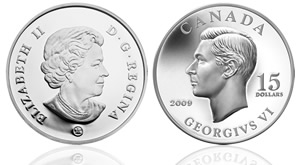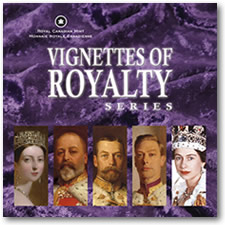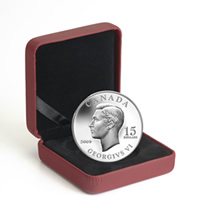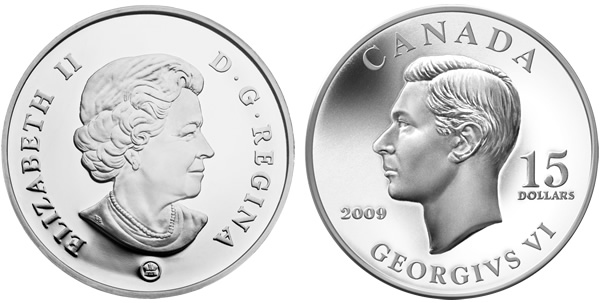2009 King George VI Sterling Silver Coin
May 6, 2009 by Darrin Lee Unser · Leave a Comment
 The fourth coin in the Royal Canadian Mint’s Vignettes of Royalty Collection has been released, and features the likeness of King George VI.
The fourth coin in the Royal Canadian Mint’s Vignettes of Royalty Collection has been released, and features the likeness of King George VI.
Those familiar with Canadian coinage will no doubt recognize this profile of the King as it appeared on multiple denominations during the years from 1937 – 1952.
Collectors are sure to be impressed with the ultra-high relief quality of the coin as it has been minted with the same procedure normally used only for medals.
History of King George VI
King George VI was born Albert Frederick Arthur George on the 14th of December, 1895 to the Duke and Duchess of York. At birth, he was fourth in line to the throne, preceded by his Grandfather, his Father and his older brother Edward.
 Fourth in line really meant that he would likely never become King. As the rules for succession dictate, as a King or Queen assumes the throne, any legitimate children of theirs would automatically move up to become the next in line.
Fourth in line really meant that he would likely never become King. As the rules for succession dictate, as a King or Queen assumes the throne, any legitimate children of theirs would automatically move up to become the next in line.
As his older brother Edward was to become King after their father, any legitimate children Edward would have would precede Albert in the line of succession. Confusing as this may seem, it is enough to say that Albert was not expecting to ever become the Monarch.
Albert’s childhood was a normal one for a child growing up in an aristocratic family. He had little contact with his parents, and was raised and taught by servants. His childhood was marked with frequent illness and he was known to stammer.
In 1909, Albert became a naval cadet at the Royal Naval College in Osborne. Despite performing poorly, he continued his education at the Royal Navy College in Dartmouth. Shortly thereafter, with the breakout of World War I, Albert was commissioned a midshipman, and even saw action against the Germans.
On April 26, 1923, Albert married Lady Elizabeth Bowes-Lyon. Elizabeth was a descendent of King Robert I of Scotland and King Henry VII of England, but according to British Law, was considered a commoner. Had it been thought Albert would one day be King; his choice of a commoner for a wife probably would have been more scrutinized.
When Albert’s father died in 1936, his older brother Edward, who was not married at the time, assumed the throne. His reign would last less than a year, as he would abdicate in order to marry his American mistress divorcée Wallis Simpson. Political officials said the people would not support Simpson as Queen, so if Edward wanted to marry her, he would have to abdicate, which he did.
With the relinquishing of power by Edward, Albert became the King of England and took the title King George VI. His reign was not as smooth as one would hope, and was marred by the gradual change of most of the British Empire to independent states. Also, World War II would break out, and the stress of it would take a toll on King George VI’s health.
King George VI died on February 6, 1952 and his daughter, Elizabeth became the Queen.
King George VI Coin Specifications and Price
The 2009 King George VI sterling silver coin is struck 4 times and then polished by hand in a procedure that is usually reserved only for medals.
 This results in a frosted high-relief image on a proof-like field. It is composed of 92.5 % silver and 7.5 % copper, and is limited to a mintage of 10,000.
This results in a frosted high-relief image on a proof-like field. It is composed of 92.5 % silver and 7.5 % copper, and is limited to a mintage of 10,000.
With a diameter of 36.15 mm and a weight of 30 grams, this beautiful coin can be purchased from around the world for $104.95 CAD.
The effigy of King George VI was designed by T.H. Paget. Susanna Blunt designed the Queen Elizabeth II image.
The coin may be purchased on the Royal Canadian Mint website at:
$15 Sterling Silver Coin – King George VI (2009)
The final coin (featuring Elizabeth II) in the Vignettes of Royalty Collection series is set for release later this year.
King George VI $15 Sterling Silver Coin Image

![[Most Recent Quotes from www.kitco.com]](http://www.kitconet.com/images/quotes_2a.gif)




